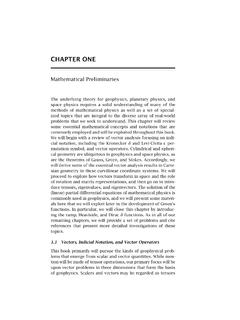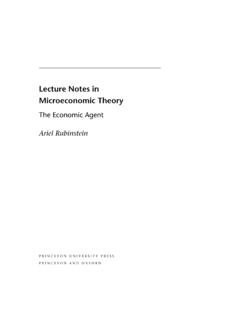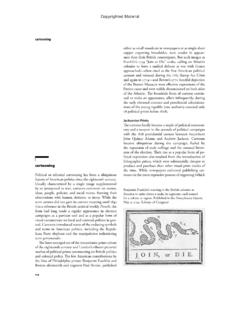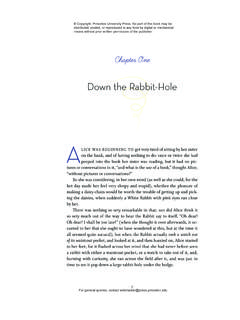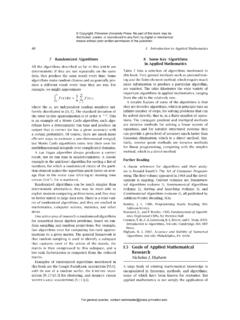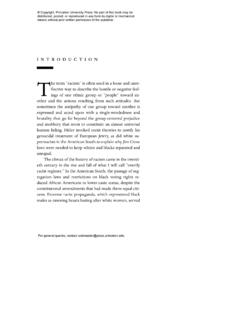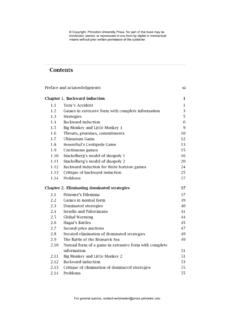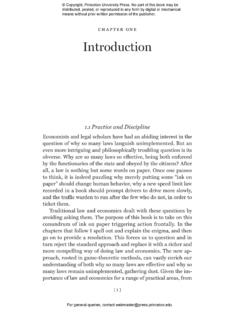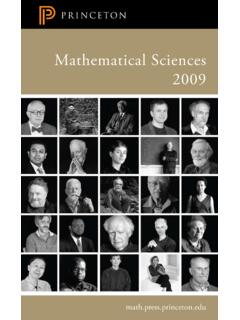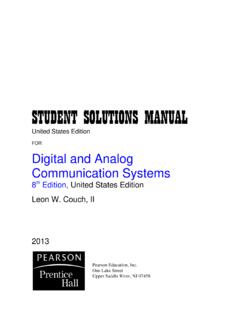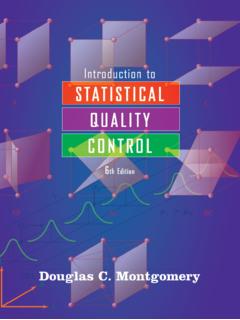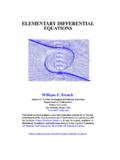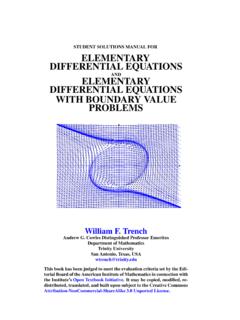Transcription of Solutions Manual Introduction Differential
1 Solutions Manual to Introduction to Differential Equations with Dynamical Systems by Stephen L. Campbell and Richard Haberman M. Ziaul Haque PRINCETON UNIVERSITY PRESS PRINCETON AND OXFORD Copyright c 2008 by Princeton University Press Published by Princeton University Press 41 William Street, Princeton, New Jersey 08540 In the United Kingdom: Princeton University Press 6 Oxford Street, Woodstock, Oxfordshire, 0X20 1TW All Rights Reserved This book has been composed in LATEX Contents Preface v Chapter 1. First-Order Differential Equations and Their Applications 1 Introduction to Ordinary Differential Equations 1 Definite Integral and the Initial Value Problem 1 First-Order Separable Differential Equations 3 Direction Fields 5 Euler s Numerical Method (Optional) 7 First-Order Linear Differential Equations 10 Linear First-Order Differential Equations with Constant Coeffi cients and Constant Input 15 Growth and Decay Problems 20 Mixture Problems 23 Electronic Circuits 25 Mechanics II: Including Air Resistance 26 Orthogonal Trajectories (optional) 27 Chapter 2.
2 Linear Second and Higher-Order Differenial Equations 29 General Solution of Second-Order Linear Differential Equations 29 Initial Value Problem (For Homogeneous Equation) 30 Reduction of Order 32 Homogeneous Linear Constant Coefficient Differential Equations (Second Order) 35 Mechanical Vibrations I: Formulation and Free Response 39 The Method of Undetermined Coefficients 45 Mechanical Vibrations II: Forced Response 58 Linear Electric Circuits 65 Euler Equation 68 Variation of Parameters (Second-Order) 70 Variation of Parameters (nth-Order) 75 Chapter 3. The Laplace Transform 82 Definition and Basic Properties 82 Inverse Laplace Transforms (Roots, Quadratics, & Partial Fractions) 86 Initial-Value Problems for Differential Equations 94 Discontinuous Forcing Functions 98 Periodic Functions 109 Integrals and the Convolution Theorem 114 Impulses and Distributions 118 iv CONTENTS Chapter 4.
3 An Introduction to Linear Systems of Differential Equations and Their Phase Plane 121 Introduction 121 Introduction to Linear Systems of Differential Equations 121 Phase Plane for Linear Systems of Differential Equations 130 Chapter 5. Mostly Nonlinear First-Order Differential Equations 142 First-Order Differential Equations 142 Equilibria and Stability 142 One Dimensional Phase Lines 143 Application to Population Dynamics: The Logistic Equation 146 Chapter 6. Nonlinear Systems of Differential Equations in the Plane 150 Introduction 150 Equilibria of Nonlinear Systems, Linear Stability Analysis of Equi librium, and Phase Plane 150 Population Models 161 Mechanical Systems 178 Preface This Student Solutions Manual contains Solutions to the odd-numbered ex ercises in the text Introduction to Differential Equations with Dynamical Systems by Stephen L. Campbell and Richard Haberman.
4 To master the concepts in a mathematics text the students must solve prob lems which sometimes may be challenging. This Manual has been written focusing student s needs and expectations. Instead of providing only the answer with very few steps, I include a reasonably detailed solution with a fair amount of detail when explaining the solution of the problem. The Solutions are self-explanatory and consistent with the notations and termi nologies used in the text book. I hope this Manual will help students build problem-solving skills. I would like to thank many people who have provided invaluable help, in many ways, in the preparation of this Manual . First, I take this opportunity to thank Professor Richard Haberman for his generous expert help, construc tive comments and accuracy checking. I would also like to thank Professor Stephen L. Campbell for assembling the final manuscript, Professor Peter K.
5 Moore for facilitating support process and Ms. Vickie Kearn of the pub lishing company for her patience and support. Finally, I must appreciate the patience of my wife, Rukshana, and my daughters, Zareen and Ehram for their understanding and compromise of summer time that was slighted because of my busy schedule. M. Ziaul Haque Southern Methodist University Dallas, TX, 75275, July, 2007. Chapter One First-Order Differential Equations and Their Applications Introduction TO ORDINARY DIFFERENTIAL EQUATIONS There are no exercises in this section. DEFINITE INTEGRAL AND THE INITIAL VALUE PROBLEM 1-7. Substitute expression for x into the differential equation 1. x =2e3t +1. = dx =6e3t .dt = 3x 3 = 3(2e3t + 1) 3=6e3t . Hence = 3. x = t 1. = dx =1. = x = t 1 =1. Hence = dt t 1 t 1 5. x = et2 . = dx =2tet2 . = 2tx =2tet2 . Hence = dt dx 7. x = e 2t . = dt = 2e 2t.
6 = 2e2tx2 = 2e2t(e 2t)2 = 2e 2t . Hence = dx t t9. dt =3e . Integrating we get, x =3e+ c. 11. dx = 5 cos 6t. Integrating we get, x = 5 sin 6t + 6 dx 11 13. dt = 8 cos(t 2 ). Use of definite integral gives x = 8 R 0 t cos t 2 dt + c. 15. dx = ln(4 + cos2 t). Use of definite integral gives x dt = R 0 t ln(4 + cos2 t)dt + c dx 1 17. dt = t4; x(2) = 3. Integrating we get x = 5 t5 + c. 17 117 t =2=3 = 32 + c = 5 . So x = t5 5 c = 5 5 . 19. dx = ln t ; x(2) = 5. Use of definite integral gives dt 4+cos2 t ln t x =5 + R t dt. 2 4+cos2 t 21. dx = e t ; x(1) = 3. dx = e t dt. Use of definite integral gives dt 1+t 1+t t t e e x 3 = R t dt = x =3 + R t dt. 1 1+t 1 1+t d2 x 23. dt2 = 15. Integrating we get dx = 15t + c1 ( dx dx dt dt = v0 at t =0= c1 = v0.) = 15t + v0. Integrating again we get dt 15 t2x = 2 + v0t + c2 (x = 0 at t =0=c2 =0.) 2 CHAPTER 1 v0 Car stops when dx =0=v0 15t =0=t = (stopping time).
7 Dt 15 So distance travelled is v0 = 15 10 m/sec. 20 20 2015 1 v 15 215 75 = 1v v( v0 )2 +15 x = = = = 2 15 2 25. d2 x = 2500. Integrating we get dx = 2500t + c1( dx = 60 at t = 0 dt2 dt dt = c1 = 60). So dx = 2500t + 60. Integrating again we get 2500 dt x = t2 + 60t + c2(x = 0 at t =0= c2 =0.)2 Car stops when dx =0= 2500t +60 = 0 dt = t = 60 (stopping time). So distance travelled is 2500 2500 60 602 x = 2 (2500 )2 + 2500 = km. x27. d2 = 2500. Integrating we get dx = 2500t + c1( dx = v0 at t = 0 dt2 dt dt = c1 = v0). So dx = 2500t + v0. Integrating again we get 2500 t2 dt x = 2 + v0t + c2(x = 0 at t =0=c2 = 0) Car stops when dx =0=v0 2500t = 0 v0 dt = t = 2500 (stopping time). So distance travelled is 20 202500 v0 v v)2( km. +x = = 2 2500 2500 5000 29. d2 x = 6t. Integrating we get dx dt2 dt = 3t2 + c1( dx dt = 3t2 + 62. Integrating again we get = 50 at t = 2 c1 = 62).
8 So dx dt = x = t3 + 62t + c2(x = 0 at t =2=Car stops when dx =0= 3t2 +62 = 0 dt c2 = 116.) q 62 = t = (stopping time). So distance travelled is x = t(62 3 t2) 116 = q 62 (62 62 ) 116 33 q 62 3 2( 2 3 116 km. = 3 )62 116 = 2 62 3 dV So dy 31. (a) V =volume, dt = Qm3/h. Let snow depth be y. dt = c y = ct + c1(y = 0 at t = 0 c1 = 0). Thus y = ct. Now consider the snowplow has moved x over the time t and the approximate change in volume over this time is V. Hence V x V = w( x)y = wct x t = wct t . Now taking limit as t 0 we get dV = Q = wct dx dx = Q = 1 with wc dt dt dt wct kt k = . (b) dx = Q 11 . Separating the variables we get, R dx = 1 R 1 dt dt kt kt x = k ln t + a. At 11 t = 3 and x(3) = 0. So 0 = k 1 ln 3 + a 1 a = k 1 ln 3. Then at noon (t = 4), x(4) = 1 ln 4 ln 3 = 1 ln 4 .kk k 3 33. d2 y = g = m/sec2 . Integrating we get dt2 dy = + c1( dy dy = v0 at t =0= c1 = v0.)
9 So dt dt = + v0. Integrating again we get dt y = 92 .8 t2 + v0t + c2(y = 0 at t =0=c2 =0.) At maximum height dy =0=v0 = 0 v0 dt = t = (time at maximum height). So maximum height is = 1960 m/sec. 20 20 20y = 2 ( v0 )2 + = 1 v 100 = 1 2 v v = = FIRST-ORDER DIFFERENTIAL EQUATIONS AND THEIR APPLICATIONS 3 35. d2 y = g = m/sec2 . Integrating we get dt2 dy = + c1( dy = 0 at t =0=c1 =0.)dt dt So dy = Integrating again we get y = t2 + c2dt 2 (y = 200 at t =0=c2 = 200). y = t2 + 200. Now to fall, 2 q 400 20y =0. So 0 = 2 t2 + 200 2 t2 = 200 = t = = sec. 37. Since x(t0) = x0, the general solution x = Rtf t dt + c becomes 0 x0 = Rt0 f t dt + c = c = x0 Rt0 f t dt. Hence the solution is 0 0 x = Rtf t dt + x0 Rt0 f t dt = x0 + Rtf t dt. 00 t0 FIRST-ORDER SEPARABLE DIFFERENTIAL EQUATIONS dx x+1 dx dt 1. dt = t . Separating variables gives R x+1 = R t.
10 Integrating we get, ln x +1=ln t+ c1 ln |x+1| = c1 x+1 c1 t|x+1 | c1| | |t| = edx tt = e= c x = ct 1. 3. dt = e . Separating variables gives R dx = R etdt. Integrating we get, x = et + c. 5. dx = tx +4x +3t +12 = (x + 3)(t + 4) . Separating variables gives dt dx t2 R x+3 = R (t + 4) dt. Integrating we get, ln x +3 = 2 +4t + c1 2 ||2 2 . dx |x +3| = ec1 e t2 +4t x = ce t+4t 3 where c = ec1 7. dt =3. Separating variables gives R dx = R 3dt. Integrating we get, x =3t + c. dx 59. dt = x . Separating variables gives R x 5dx = R dt. Integrating we get, x 4 = t + c. Using x(2)= 1 we get, 1 =2 + c c = 9 .4 44 Substituting c we get x 4 = 9 4tx = (9 4t) 1/4 . dx 11. dt = x2 cos(t2). Separating variables gives x 2dx = cos(t2)dt. Using 2 definite integrals we get, Rxx 2dx = Rtcos(t )dt 10 22 1 +1 = R 0 tcos(t )dt 1 = 1 R 0 tcos(t )dt x x 1 x = 2 1 Rtcos(t )dt 0 13.
